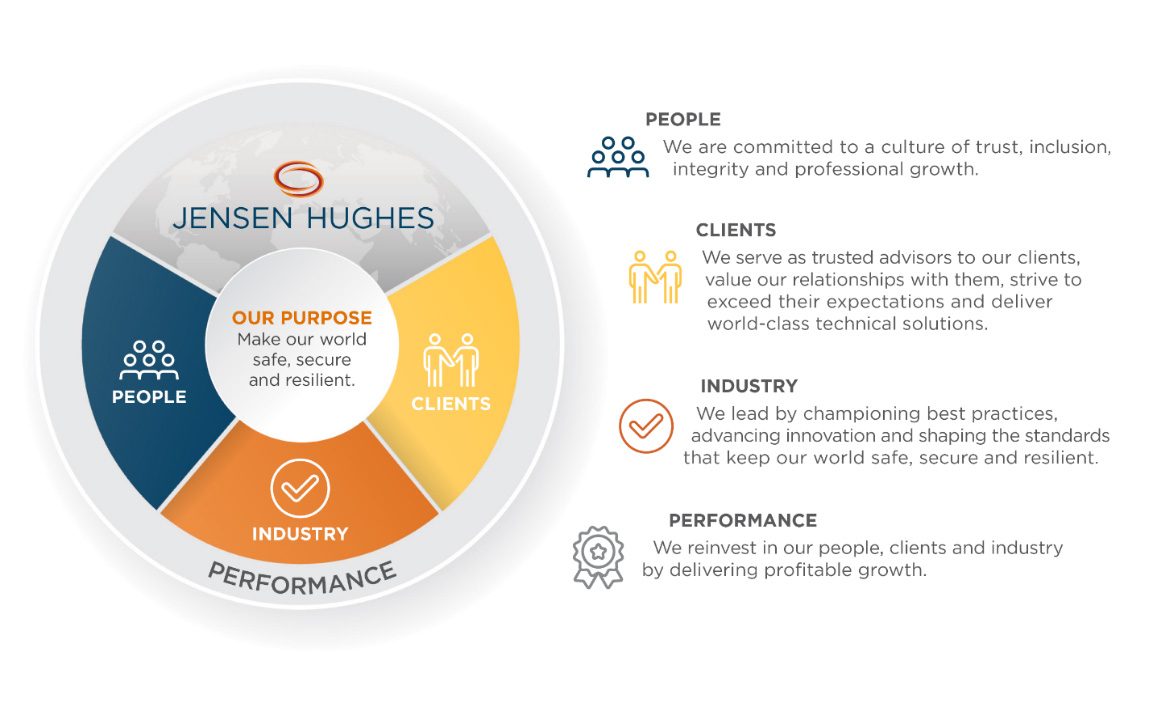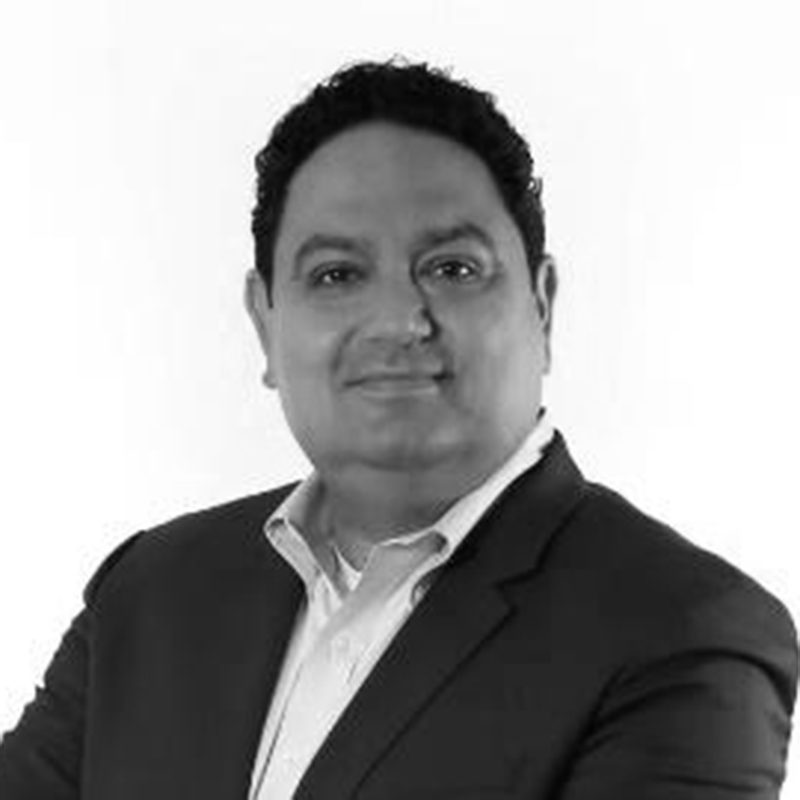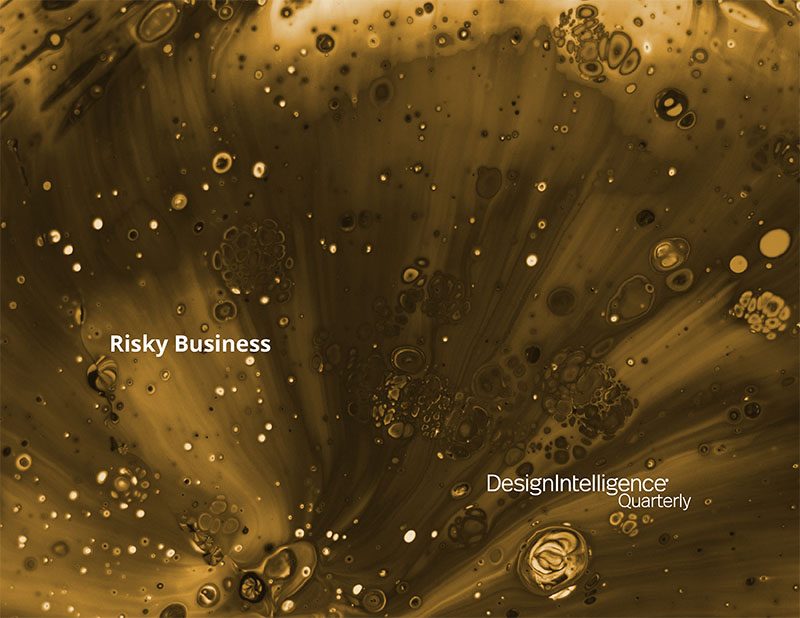Risky Business
by Pankaj Duggal
President & COO, Jensen Hughes
December 8, 2021
Jensen Hughes President and COO Pankaj Duggal discusses his firm’s innovative initiatives to manage and mitigate risk — and transform customers’ mindsets.
DesignIntelligence (DI): To set a foundation, how would you describe your organization’s mission and vision? Who is Jensen Hughes, what do you do and how are you positioned in the AECO marketplace?
Pankaj Duggal (PD): Last year, through engagement with 400+ employees, we evolved our mission and vision — our purpose and principles — to reinforce our focus on people, clients, industry and performance.
Since 1939, we have protected what matters most to our clients through innovative, compliant, reliable solutions. By adding deep functional expertise and technology know-how, we can address the complexities of safety and security challenges across the risk management spectrum. As the largest global safety, security and risk-based engineering and consulting firm, we offer more than 1,450 people operating in 15 countries and we have delivered projects in 100+ countries worldwide. We are also the largest specialist fire engineering firm in the world, with roots that trace back to Schirmer Engineering, Rolf Jensen & Associates, Hughes & Associates and Aon FPE.
Jensen Hughes Mission and Vision

Our experts have technical expertise across the entire spectrum of fire and life safety services, in areas such as alarm and security systems design, smoke control, modeling, code consulting and fire forensics. Over the last several years, we have continued strategic acquisitions to expand our global capabilities in fire protection engineering, risk and hazards, security risk consulting, forensic engineering, emergency management and planning and other related disciplines.
With a strong focus on the built environment, roughly half our business aligns with architecture and engineering partners. We work with the world’s leading designers and constructors to unleash the power of innovative design through expert technical solutions in the architecture, engineering and construction markets.
DI: How does that relate to your personal mission? Why are you here? What are you trying to accomplish?
PD: With 30-years in the A&E industry and 21-years at Jacobs in a global senior management role, I saw Jensen Hughes as a unique opportunity to understand the safety, security and risk management market. More importantly, it offered me an opportunity to convince my peers and partners in the A&E community of the value in early engagement of Jensen Hughes’ expertise during design and construction. Too often, we get brought in too late in the design process to make positive impacts on design directions and outcomes.
DI: Operating on a global scale as you do, what challenges do you face in your pursuit of transformational innovation? How are the topics of R&D and innovation approached organizationally? How are they funded, led, rewarded and implemented firm-wide?
Jensen Hughes Technology-Enabled Consulting Services Platform

PD: We are committed to technology-enabled solutions platform and professional services delivery through transformational innovation as a core value. Almost all companies in our industry face the challenge of funding these initiatives and making them a priority. After all, there is so much pressure on the P&L these days from various business needs in the short-term, while R&D and innovation are a long-term play. Creating a balance in the competing priorities and staying focused on the long-term strategic outcomes relative to R&D and innovation have been key to our focus on driving innovation. As a result, these topics are fundamental ongoing job expectations for almost everyone, especially our technical leaders. We have technology experts who are specialists in software development and integration, and all staff are evaluated and rewarded for their contributions in innovation, whether in technology, process or discipline content and expertise.
DI: Can you share some specific examples of innovation initiatives you’re pursuing? Things you are putting into practice in key solution areas to add value for yourselves, customers and communities?
PD: The first ones that come to mind are our technology-enabled solutions. We are focused on tools that leverage our expertise and help our customers. All our platforms aim to do 3 things: achieve compliance, reduce overall client risk, and streamline processes to drive intelligent solutions yielding lower operating costs.
One example is called SmartPlan™. SmartPlan is an interactive, database-driven tool we use to help our Industrial clients mitigate
risk and integrate their hazardous management, emergency evacuation plans and business continuity plans into one interface on the client
side. When something goes wrong, they have everything they need in one place to manage that situation without the assistance of
third-party consultants.
Similarly, let’s talk about our ProtectAdvisr™ tool. With increasing numbers of fires and disasters, as well as health systems expanding through mergers and acquisitions, the need for real-time coordination, communication and response across organizations continues to rise. ProtectAdvisr™ is designed to aid healthcare facilities in streamlining their emergency management, life safety and fire safety procedures, improve preparedness, and collect and analyze data. Our user-friendly, web-based technology can be customized for use in a single community hospital, a long-term care facility or across an entire national health system. As the central hub for accreditation/licensure compliance, communication, coordination, response and reporting, using our tool helps facilities save time and money while further improving CMS compliance and safety for patients and staff.
DI: I assume that is digital, cloud-based and accessible on remote devices in case the facility goes down?
PD: Exactly. These tools are digital, cloud-based and can be accessed through mobile apps.
DI: One of your mainstays has always been in structural and infrastructure consulting.
What’s new there?
PD: In Forensics we are focused on things like concrete aging, structural failures, green concrete and other
infrastructure-related areas – all with the purpose to make our world safe, secure and resilient. We’re analyzing and doing
risk assessment for fires in tunnels and tunnel ventilation issues. We now have an accredited concrete lab in Chicago. These practices
relate directly to the U.S. infrastructure bill. The unique innovative aspects of these areas are tools like computational fluid
dynamics (CFD), for example, for trains or vehicles carrying hazardous materials. Our industry partners have in-house experts and tools, but
not to the extent
we do.
Another growing area for us and the country is in energy storage systems with a focus on lithium-ion batteries, which presents a huge fire
and explosion risk. This a huge new movement these days. And the emphasis is on reducing cost and size. This is great from a clean energy
perspective and its where we need to be going. Warehouse battery racks and shelving are becoming stock now. But these systems come with
hazards, manufacturing deficiencies, faulty electrical connections, failed cooling systems and various risk and reliability events. Our
focus is on risk mitigation and
code compliance.
Manufacturers, clients and the world are eager for these solutions, but local regulatory agencies often don’t have the codes and expert in-house knowledge to deal with these emerging technologies. So, the industry has several challenges. Automotive, manufacturing and data center clients are installing large-scale battery and photovoltaic cell installations for backup power. Transportation and commercial and institutional clients are too. The need is tremendous, but the risk is ever-present. We are supporting reviews and end-user clients for safe installations and working with local authorities at both ends to support this rapidly growing market. Our focus is on consequence modeling, looking at different options and scenarios, from start-up through load flow and assessment analysis to commissioning and operations as well as code compliance.
DI: Clearly a complex set of problems that need new integrated systems to collect, analyze, synthesize and visualize the data using systems-based tools.
PD: That’s right. Along those lines, we are getting involved with risk-informed maintenance, and the internet of things. This transcends traditional static BIM-based facility management, where your system would tell you to change all the lightbulbs every six months.
We are leveraging what we do in the nuclear and power space, where we do a lot of probability risk analysis (PRA) and looking to cross-pollinate solutions in other industry segments. In the nuclear industry, there is not much room for risk. In risk-informed maintenance (RIM) we look at the lifespan of various components and provide data that tells clients to replace them before they reach the end of their design life, rather than a routine replacement schedule. In RIM, we analyze the probability of a component failure occurring and extend utilization of that component based on the PRA. As a result, you replace it optimally and minimize downtime while optimizing your cost. We had a recent project in which the local authorities were not ready to approve a design, because of the perceived risk of failure. So, we leveraged our PRA team to analyze the issue. They discovered that the risk probability of the failure occurring was less than someone getting hit by lightning. Once the code officials understood that, they approved the design. Using data, analytics and visualization helps leverage our technical expertise. It can unlock minds to help people see and understand things and sometimes even change their preconceived mindsets.

DI: Are there other emerging service areas?
PD: A big new area is in wildfire mitigation and management. This is tied to responses for the events that have been happening in California over the last two decades. It has become an emergent global problem. We are also seeing it happening in Australia and Europe. With climate change, these impacts are likely to worsen and become increasingly profound. To mitigate these challenges, we are focused on the wildland and urban interface with technology, integrated solutions and the industry. A wildfire is one thing in a forest, but when it moves to the urban context it threatens humans and our built environment. People are having trouble insuring their properties in California. Insurance companies are now asking for wildfire plans. Visualizations, assessments, wind and weather patterns, and dynamic analyses play a huge role, and they impact design in significant ways — knowing these risks, planning a site, dealing with challenges of fuel storage in high-risk areas and vegetation management. You need mass notification systems, structural hardening assessments, and smart building envelopes, fire mitigating roof, windows, and related systems. We also perform defensible space assessments for things like firefighting access, separation analysis and emergency power recommendations. Solutions could be as simple as having exterior sprinklers and fire protection measures against wildfires. At the community level, we work with the local authorities to help develop the training, drills and exercises for these situations if and when they might occur.
DI: What are some of the pitfalls of such investments for software, hardware, infrastructure and training?
PD: There’s a reason we are a leader in this space. When we look at solving emerging problems and deploying them globally, our team always looks to technology-enabled solutions. But we’ve learned that one can’t expect a return on these kinds of investments in 12 months, we are in it for the long play. Sometimes we offer these tools through a subscription service to our clients and industry partners. Our software team works with the discipline experts to capture the right nuances. It can be anywhere from 12 to 36 months before we can launch a software product, but it’s an essential aspect of our business. And it’s one of the things that attracts the best talent to Jensen Hughes. Hopefully, we’ll continue to shorten those development cycles.
DI: The common theme of risk management and mitigation prevails through everything you are sharing. Designers typically don’t think about that. The entrepreneurial mindset is not something most architects, engineers and consultants are predisposed to have. They are not taught it, encultured to it or rewarded for it. Folks within in a code, fire protection and risk management consulting organization like yours, seem like they might be focused on following the rules. Am I stereotyping inappropriately? Enlighten me on some instances in which you are having to innovate to maintain your lead position in the industry.
PD: That’s a fair assessment of our industry and its people. I can say that because I am part of the industry. Construction is one of the slowest industry segments to innovate and adapt. Not much has changed. In our space, our people like to mitigate risk, not create it. Do you have to follow rules? Yes, but you also have to think outside the box — to think about things others haven’t. As technology impacts other industries, we must get smarter and adapt faster. Electric vehicles are a good example. Look at what happens when an electric vehicle is in an accident and catches fire. In one such incident in Texas, it took 30 times the water to extinguish that fire. There’s room for innovation there. The first responders are using water. Perhaps we shouldn’t be using water? It’s just one example, but we at Jensen Hughes are always pushing to find that balance.
DI: In managing your own risk — the future of your organization — what is the future telling you, and what are some of your responses? How are you looking over the horizon in specific ways?
PD: The examples I just offered illustrate what we are asking ourselves about. If we continue to do what we’ve
always done, we won’t be growing and innovating. As a result, we are constantly looking at external industries and the larger global
context. At Jensen Hughes we are continually looking at different ways of solving our clients problems while leveraging our global talent
base and technical expertise to bring innovative solutions. We continue to make investments in strategic acquisitions that help grow our
technical expertise and market presence. Per our Purpose Statement, our mission — and the innovation that enables it — is
always driven by our people, our clients and the industry to achieve our vision of increased performance
and growth.
Pankaj Duggal serves as the president and chief operating officer for Jensen Hughes, a global engineering and consulting firm with 1,450 employees. In his role, Duggal provides business leadership across the company’s operating divisions and supports the achievement of strategic initiatives and financial goals. Previously, he was senior vice president at Jacobs. His interest areas include strategy development, integrated design, safety and risk, alternative delivery, total cost of ownership and high-performance built environment. He brings a strong focus on leveraging inclusion and diversity for growth-oriented business approach and collaborative decision-making. Duggal serves on the Dean’s Advisory Board for the College of Architecture and Urban Planning at the University of Michigan and on the advisory boards for the Design Futures Council and the Greater Washington Board of Trade.


